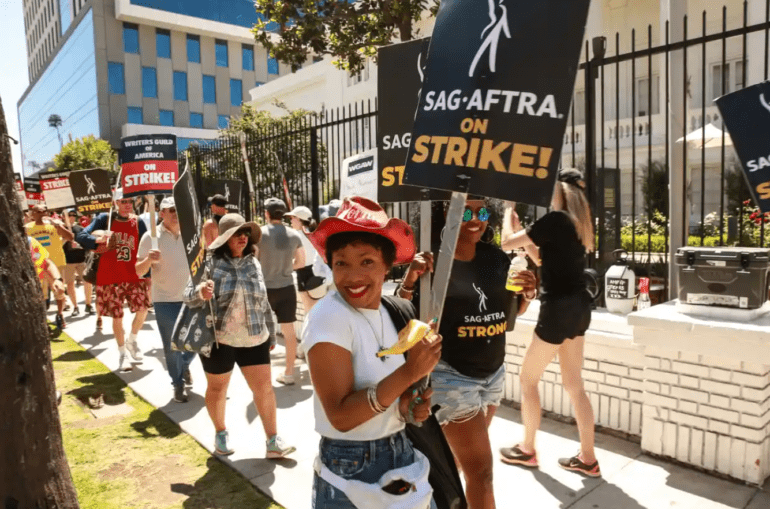TL;DR:
- Hollywood actors and writers join in an unprecedented “double strike” against the encroachment of AI technology on the entertainment industry.
- The battle is not just for actors but for every worker, from extras to stars, to protect jobs from being replaced by AI.
- Concerns include deepfake technology targeting celebrities and the ownership and usage rights of digital replicas.
- Hollywood artists assert that AI cannot replicate the depth of human creativity and expression.
- The rise of AI has implications beyond Hollywood, with workers in various industries facing uncertainties over automation.
- Sag-Aftra’s unique configuration of protecting A-list celebrities and entry-level performers strengthens solidarity among all workers.
Main AI News:
The clash between human creativity and the relentless rise of artificial intelligence (AI) has reached a crescendo in Hollywood, where actors and writers have taken a historic stand against the encroachment of technology on their beloved craft. Leading this unprecedented “double strike,” the Screen Actors Guild-American Federation of Television and Radio Artists (Sag-Aftra) and the Writers Guild of America (WGA) have rallied together to safeguard the very essence of the entertainment industry – the human touch.
For Hollywood hopefuls like Chivonne Michelle, who initially honed her acting skills at New York University, the path to success often starts with smaller roles, such as being a background actor. These seemingly humble positions serve as vital training grounds and stepping stones for many aspiring stars. However, the surge of AI poses a significant threat to these entry-level and working-class jobs, leaving actors like Michelle worried about their future in the business.
But this isn’t merely a battle for the actors; it’s a fight to protect every worker within the entertainment industry, from the extras to the seasoned stars. The major studios’ insistence on integrating new technologies into production processes has led to a dramatic standstill, with both sides unwilling to back down. Months of heated negotiations and a prolonged standoff seem inevitable.
The risks posed by AI extend far beyond Hollywood, with various professions facing uncertainty in the face of automation. Yet, the voices of these celebrated performers resonate globally, amplifying the concerns of UPS workers, Starbucks employees, teachers, and nurses, among others. The powerful force of Sag-Aftra represents not only actors but the collective interests of countless workers.
The heart of this battle lies in the essence of human creativity. Hollywood, as a bastion of artistic expression, grapples with the fundamental question: Can AI truly replicate the depth of human emotions and creativity? The answer remains elusive, and Hollywood artists assert that AI-generated versions can never replace the uniqueness of performances like Marlon Brando’s iconic portrayal in “The Godfather.” Understanding the intricacies of human expression and emotion lies at the core of this ongoing conflict.
Beyond the artistic concerns, the rise of AI-powered deepfake technology adds another layer of apprehension. Celebrities face the unsettling reality of their voices and likenesses being manipulated for deceptive purposes, from advertisements to explicit content. In the eye of this storm, the Alliance of Motion Picture and Television Producers (AMPTP) and Sag-Aftra clash over the ownership and usage rights of digital replicas.
Background actors, often overlooked, are in the crosshairs of these discussions. AI’s potential to replace these roles is viewed as a cost-cutting measure, endangering the livelihoods of many in the industry. Sag-Aftra’s demand for robust protections and consent rights becomes all the more crucial, with actors fearing that their digital replicas might be used in exploitative or offensive ways.
While some skeptics dismiss the hype around AI’s imminent threat, others argue that the real challenge lies in distinguishing genuine AI advancements from marketing exaggerations. The complex nature of AI technology demands a nuanced understanding, not just by actors but also by studio executives and investors, who need to grasp its true potential and limitations.
Amid this tumultuous landscape, Hollywood stands united, with A-list celebrities and entry-level performers alike bound by the same union contract protections. This unique configuration strengthens solidarity among all workers, fostering an environment where stars and newcomers share a common cause.
Conclusion:
The clash over AI in Hollywood represents a defining moment for the entertainment industry. It is not only a battle to preserve jobs but also a fight to safeguard the essence of human creativity and expression. As the industry unites to protect its soul from the encroachment of artificial intelligence, it sets a precedent for other markets to consider the implications of technology on their own unique human elements. The outcome will shape the future of artistry in an increasingly digitized world, as Hollywood takes a stand for the irreplaceable value of human contributions.

